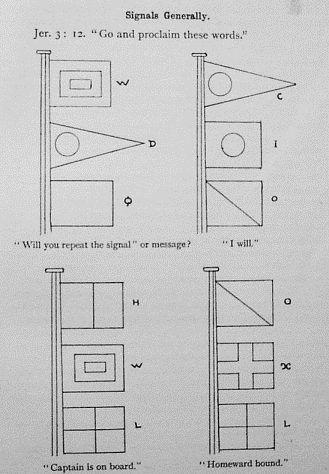I remember as a small boy attending the family service at our local church and seeing the vicar illustrate his sermon with a box of washing powder; the image has clearly stuck with me, but nothing of the message he was attempting to convey. That this rather desperate style of Biblical analogy is part of a venerable tradition is evidenced by this century-old little book, which is intended to provide useful material for the beleaguered Sunday School teacher, to help to impart the gospel to his or her restless charges. In this case, by waving coloured flags at them.
One can see the line of thinking behind it: the core of the Bible message is about being saved; and so is the International Code of Signals for ships at sea. Thus one can take various Bible texts and translate them into their equivalent signals, to provide a memorable visual display that will entertain and edify the little darlings seated cross-legged on the floor. (Or, as I suspect, utterly mystify them.)
For example, to represent the text “Go and proclaim these words” (Jeremiah 3:12) the signals for “Will you repeat the signal?”, “I will”, “Captain is on board” and “Homeward bound” are shown. A much-needed gloss explains for instance that “Captain is on board” means that “Christ wishes to be on board the Christian's heart”.
In the same earnest vein, the text “Beware therefore lest that come upon you” (Acts 13:40) is illustrated by the codes for “Prepare for a hurricane”, “Thick fog coming on” and “Iceberg”. The analogy is getting stretched a bit here, isn't it? The full text is “Beware lest that come upon you, which is spoken of in the prophets”, not “that which is spoken of in the shipping forecast”.
Likewise, “I have called, and ye refused” (Proverbs 1:24) is indicated by “You are in a dangerous position”, “Under no anxiety”, “You had better take on a pilot at once”, and “Pilot not necessary”. A sort of dialogue - do you see? - between God and the errant sinner, who will not acknowledge his need for a pilot (the “Lord Jesus Christ” needless to say).
Perhaps realizing that the signal flags' potential for fascination is not limitless, the authors have included several other sources of inspiration, while keeping to the trusty nautical theme. So it is demonstrated that one can use not only flags to communicate the eternal truths of the Bible but also “distant signals”, such as semaphore, to render for example “Purge your conscience from dead works” (Hebrews 9:14) as “Damaged rudder, cannot steer”, followed by its response “I will take you in tow”.
A section is also devoted to “The Lifeboat and its Lessons”. The lifeboat is shown to be a profuse source of telling analogies, the boat itself representing the Church, with its air-tank full of the Holy Spirit and its ballast “a firm grip of the fundamental doctrines of the gospel”. A great deal of play is made with acrostics and similar devices, including this elegant contrivance to accompany a picture of a lifeboat house, in which everything is kept ready for use:-
R ecognised needs
E mergencies prepared for
A pparatus ready
D isciplined men
Y okes to be borne
A further illustration of the concept of readiness is found in a section titled “The Christian Armour” - one of a number of odds and ends filling out the rear of the volume - under the sub-heading “Shoes”:-
We have seen how these gospel shoes equip us so that we are ready for service, and how they lead us to reclaim or win back that which is lost, but as they are shoes of the gospel of peace, I like to think that I can use mine in reconciling those who quarrel, either with each other, or with God, as I remember Jesus once said “Blessed are the peacemakers”.
So if I have this right, the soldier of God uses his shoes to sort out quarrels. By kicking those who don't follow the gospel of peace? But that's the danger of imagery: it's liable to be misunderstood.
I wonder if some evangelical would-be mariner, over-excited by his reading of this volume, chose to accompany his prayers with semaphore flashes, to the bafflement and perhaps indignation of the naval authorities. Faced with the ire of a bewhiskered old sea-dog, would you dare to claim that you weren't signalling distress in the literal sense, but merely abasing yourself before your Lord, as a miserable sinner?
“Blisterin' barnacles! @#!!! Keel-'aul 'im!”

Leave a comment